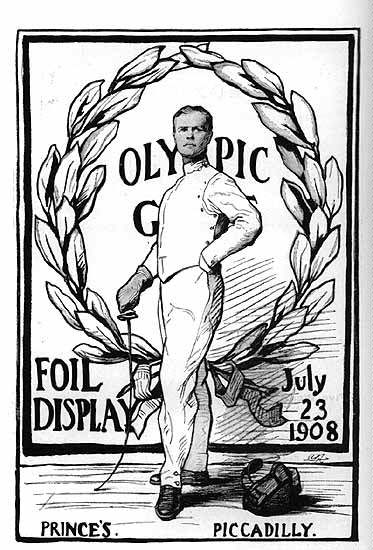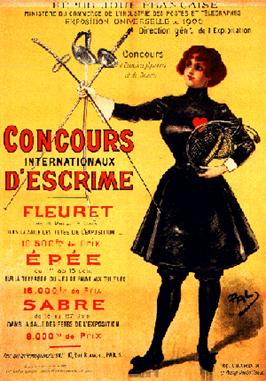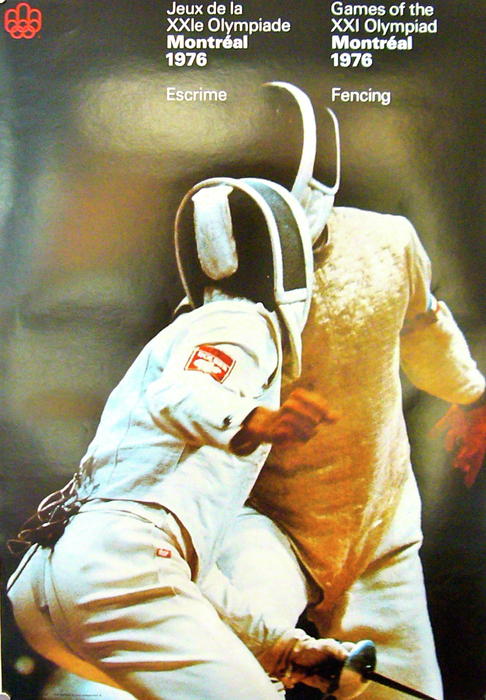International Institute for Sport History
Library and Museum
~
FENCING ENDOWMENT
&
FENCING COLLECTION

The IISOH would like to acquire original material such as this poster
from the 1908 London Exposition and Olympic Games
The IISOH is seeking $1 million (one million Dollars)
from a donor in order to establish an endowment for the sport of FENCING.
This is a naming opportunity for the donor to have a perpetual identification with the sport
of FENCING by establishing a trust fund for the development of this collection.
The endowment would be named by the donor
with the approval of the IISOH Board of Directors.
The endowment is invested in a permanent trust fund.
Only the quarterly earned interest will be used for development of the
FENCING collections in both the Library and Museum.
For more details about the endowment program, please click here.
CASH DONATIONS:
Cash donations IN ANY AMOUNT are always welcome --
You can become a CHARTER MEMBER with a $25.00 donation aned all donations
over $25.00 will receive a lifetime acknowledgement.
The Board of Directors would like to thank all donors for their support. Every donation will be recognized
in our publications or web site pages. Donations over $250 will be honored by the Board of Directors with
an engraved brick to be placed on the patios or walkways that will surround the cafe and scultpure gardens.
Larger donations will be acknowledged with larger plaques in marble, stone or bronze and displayed on designated
walls of honor inside or outside the buildings in accordance with the instructions of the Board of Directors.
To become a Charter Member or make a cash donation --
go to this page now.


NON-CASH DONATIONS:
The IISOH Library and Museum eagerly accept donations of material that are within the scope of its collections.
Collectors are encouraged to send us donations of books, monographs, theses & dissertations, magazine and subscription collections for the library,
as well as medals, pins, torches, posters, artwork and collectables for the Museum.

LIBRARY donations:
-
Material in ANY language, including but not limited to English, French, German, Italian, Spanish, Portugese,
Flemish, Swedish, Finnish, Danish, Norwegian, Latin, Greek, Russian, Ukrainian, Serbo-Croatian, Hebrew, Arabic, Japanese,
Chinese, Farsi, Sanskrit and dozens of others. The scope of this collection is international and comprehensive.



- Books, Monographs, Theses & Dissertations
- Bound and unbound serials (magazines, journals, etc) and Newspapers (hard copies or microfilm)
- Juvenile literature
- Dictionaries, Encyclopedias, Reference books
- Manuscripts, Archives of organizations, Original letters of correspondance
- Ephemera (pamphlets, booklets, folders, flyers, tickets, etc).
- Miscellaneous items that do not fit into the above categories
MUSEUM donations:




- Fencing Posters


- Antique Fencing equipment
- Statuary in bronze, resin, plaster, terracotta, etc.
- Paintings, Serigraphs, Drawings, etc.

- Photographs, prints, negatives, glass plates, etc.
- Films, movies, videos, dvd's, especially older films in need of archival preservation
- Music, records, tapes, sheet music
- Graphics, 16th - 19th century lithographs & prints
- Fencing-related medals, awards, trophies
- Fencing commemorative medals, participation medals, badges, etc.
- Fencing pins, flags, banners, advertising
- Fencing-related memorabilia
- Philatelic items, stamp collections, illustrated postcards on Fencing








- Numismatic items, coins, exonumia with Fencing themes
- Uniforms, clothing, textiles, fashions
- Physical education, recreation and play equipment related to Fencing

This image illustrates the three modern weapons used in modern fencing, the foil, the epee and the sabre.
The Foil was originally created as a practice weapon before a duel. The target is the opponent's torso.
Only the tip of this sword is used to hit the target. In case of a double hit, the attacker wins the point.
The Epee (in the middle) is the weapon for the duel. The entire body is the target but still the only part of
the sword to score is the tip. In the case of a simultaneous hit each fencer scores a point. The Saber (right)
was the weapon of the soldier, using the enire blade to hit the body above the belt. In case of a double hit, both
fencers score. The sabre is the closest to the swashbuckling fights of pirate movies.
These lists are not comprehensive and are limited only by your imagination!
Keep in mind that FENCING is an international sport that has had various forms in almost every civilization in the world.
We use the word "fencing" for this subject but several other words are very closely related to this topic, including "pirates and swashbucklers,
swords and sword fights, duels and dueling, samurai and ninja, gladiator and gladitorial combat,
Fencing weapons have varied in shape and style since ancient civilizations where spears and swords were the primary weapons.
Ancient Greek and Roman swords were made of metals such as bronze and iron, and rarely exist today as they were melted down
for new weapons by conquering civilizations. Renaissance and later era weapons can frequently be found at fine auctions.
Japanese swords are famous for their Samurai history and are among the most cherished world-wide.
A very sizable portion of the literature on FENCING comes from the 16th, 17th, 18th & 19th centuries in languages such as French, Italian, Spanish and German,
which we are eagerly seeking for our Library. Many of the earliest printed books in Europe included fencing instructions and illustrations.
Fencing is a major part in literature, a major theme in the plots of such stories as such as in the Three Musketeers, Robin Hood and Zorro.



Swashbuckling pirates would not be as exciting without their swords. The subject of Duelling is closely related to fencing -- it is the origin of the sport
used today in the Olympic Games -- a battle of honor where the combatants survive to shake hands and drink together afterwards. Many famous
people have had their hands on some type of sword, either as athletes in competition or as roles in films, such as British Prime Minister Winston Chruchill
fenced as a schoolboy, World War II General George Patton learned to fence at West Point and competed in the 1912 Olympic Games in the pentathlon,
American musician Neil Diamond was a saber fencer as a university student in New York, French educator Pierre de Coubertin was founder of the modern
Olympic Games and also a fencer. In film and television Grace Kelley, Errol Flynn, Guy Williams and Antonio Banderas are just a few actors who have
waved swords, while in real life Captain William Kidd (1645-1701) used a cutlass as a sailor/privateer and was eventually executed as a pirate.



Winston Chuchill, Camptain Kidd and George Patton all had fencing skills
The Institute's long-term goal is to develop the most comprehensive collection in the world,
with every book ever printed on the subject. Please be generous with your support.
For additional subject areas that we seek, see the list in the SUBJECTS area for endowments.


The IISOH is a Pennsylvania Non-profit, Educational, Literary and Research
corporation under section 501(c)3 of the Internal Revenue Code.
The IISOH is organized to operate a library and museum devoted to
History of Sport
Physical Education
Recreation
Dance
Sport in Art
Olympic Games
Donations are tax deductible

Links to other Institute pages --

Contact:
Mr. Harvey Abrams, President
International Institute for Sport History
(IISOH)
PO Box 175
State College, PA, USA 16804
email:
HAbrams@iisoh.org

This page was created February 24, 2002
This page was updated March 12, 2010
This page was updated January 2, 2012
iisoh028


























